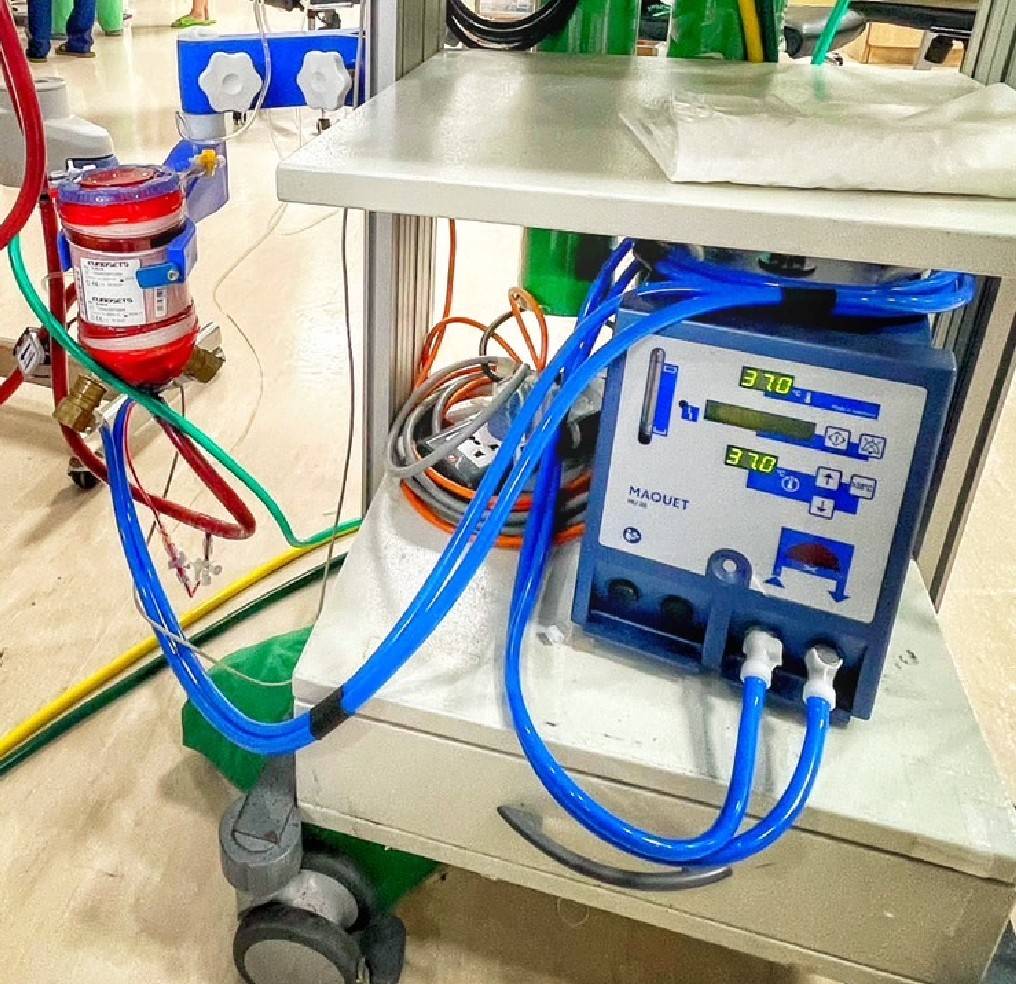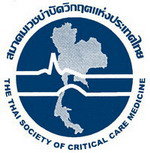Clinical characteristics and outcomes of extracorporeal membrane oxygenation used in a non-cardiac surgical intensive care unit: Siriraj experiences and literature review
ECMO used in SICU
DOI:
https://doi.org/10.54205/ccc.v31.259819คำสำคัญ:
ECMO, ECRP, ICU, Mortality, Perioperative period, Surgical patientsบทคัดย่อ
Background: Extracorporeal membrane oxygenation (ECMO) has substantially increased in frequency of use over the past decades. Occasionally, patients who require ECMO support are admitted to an ICU rather than medical or cardiac ICU, where physicians may be not familiar with the process of how to care for ECMO patients. The aims of this case series were to explore the utilization of ECMO support in a non-cardiac general surgical ICU (SICU) in terms of indications, ECMO-related complications and clinical outcomes.
Methods: Adult patients admitted to the SICU from January 2014 to June 2021 who received ECMO support were included. Demographic data, data regarding ECMO utilization and clinical outcomes were described. Current evidence and updated literature were also researched and reviewed.
Results: A total of 18 patients were admitted to the SICU and received ECMO support, but four died within four hours of SICU admission. The most common reason for ECMO support was extracorporeal cardiopulmonary resuscitation (ECPR) (9 cases, 50.0%), followed by cardiac and/or respiratory support. The majority of patients received venoarterial ECMO support (15 cases, 83.3%). Unfractionated heparin was used in 10 cases (71.4%) and the anticoagulant effect was monitored with aPTT, which was maintained at a lower range (30–50 seconds). There was no thromboembolic event, and four patients (28.6%) developed major bleeding. The overall hospital mortality was as high as 77.8%.
Conclusion: There was a small volume of cases receiving ECMO support in the SICU. ECPR was the most common reason for ECMO support in these patients. Overall, the hospital mortality was 77.8%. To improve outcomes in these patients, appropriate patient selection, well-organized protocols, and a multidisciplinary approach are mandatory.
Downloads
เอกสารอ้างอิง
Brodie D, Slutsky AS, Combes A. Extracorporeal life support for adults with respiratory failure and related indications: A review. JAMA 2019;322:557-68.
Quintel M, Bartlett RH, Grocott MPW, Combes A, Ranieri MV, Baiocchi M, et al. Extracorporeal membrane oxygenation for respiratory failure. Anesthesiology 2020;132:1257-76.
Raleigh L, Ha R, Hill C. Extracorporeal membrane oxygenation applications in cardiac critical care. Semin Cardiothorac Vasc Anesth 2015;19:342-52.
Raman L, Dalton HJ. Year in Review 2015: Extracorporeal membrane oxygenation. Respir Care 2016;61:986-91.
Combes A, Schmidt M, Hodgson CL, Fan E, Ferguson ND, Fraser JF, et al. Extracorporeal life support for adults with acute respiratory distress syndrome. Intensive Care Med 2020;46:2464-76.
Tsangaris A, Alexy T, Kalra R, Kosmopoulos M, Elliott A, Bartos JA, et al. Overview of veno-arterial extracorporeal membrane oxygenation (VA-ECMO) support for the management of cardiogenic shock. Front Cardiovasc Med 2021;8:686558.
Abrams D, MacLaren G, Lorusso R, Price S, Yannopoulos D, Vercaemst L, et al. Extracorporeal cardiopulmonary resuscitation in adults: evidence and implications. Intensive Care Med 2022;48:1-15.
Kelly B, Carton E. Extended indications for extracorporeal membrane oxygenation in the operating room. J Intensive Care Med 2020;35:24-33.
Monaco F, Belletti A, Bove T, Landoni G, Zangrillo A. Extracorporeal membrane oxygenation: Beyond cardiac surgery and intensive care unit: Unconventional uses and future perspectives. J Cardiothorac Vasc Anesth 2018;32:1955-70.
Charlson ME, Pompei P, Ales KL, MacKenzie CR. A new method of classifying prognostic comorbidity in longitudinal studies: development and validation. J Chronic Dis 1987;40:373-83.
Knaus WA, Draper EA, Wagner DP, Zimmerman JE. APACHE II: a severity of disease classification system. Crit Care Med 1985;13:818-29.
Vincent JL, Moreno R, Takala J, Willatts S, De Mendonca A, Bruining H, et al. The SOFA (Sepsis-related Organ Failure Assessment) score to describe organ dysfunction/failure. On behalf of the working group on sepsis-related problems of the European society of intensive care medicine. Intensive Care Med 1996;22:707-10.
Singer M, Deutschman CS, Seymour CW, Shankar-Hari M, Annane D, Bauer M, et al. The third international consensus definitions for sepsis and septic shock (Sepsis-3). JAMA 2016;315:801-10.
ARDS Definition Task Force, Ranieri VM, Rubenfeld GD, Thompson BT, Ferguson ND, Caldwell E, et al. Acute respiratory distress syndrome: the Berlin definition. JAMA 2012;307:2526-33.
Section 2: AKI Definition. Kidney Int Suppl (2011) 2012;2:19-36.
Rao P, Khalpey Z, Smith R, Burkhoff D, Kociol RD. Venoarterial extracorporeal membrane oxygenation for cardiogenic shock and cardiac arrest. Circ Heart Fail 2018;11:e004905.
Wilson-Smith AR, Bogdanova Y, Roydhouse S, Phan K, Tian DH, Yan TD, et al. Outcomes of venoarterial extracorporeal membrane oxygenation for refractory cardiogenic shock: systematic review and meta-analysis. Ann Cardiothorac Surg 2019;8:1-8.
Grunau B, Hornby L, Singal RK, Christenson J, Ortega-Deballon I, Shemie SD, et al. Extracorporeal cardiopulmonary resuscitation for refractory out-of-hospital cardiac arrest: The state of the evidence and framework for application. Can J Cardiol 2018;34:146-55.
Kim SJ, Kim HJ, Lee HY, Ahn HS, Lee SW. Comparing extracorporeal cardiopulmonary resuscitation with conventional cardiopulmonary resuscitation: A meta-analysis. Resuscitation 2016;103:106-16.
Gravesteijn BY, Schluep M, Disli M, Garkhail P, Dos Reis Miranda D, Stolker RJ, et al. Neurological outcome after extracorporeal cardiopulmonary resuscitation for in-hospital cardiac arrest: a systematic review and meta-analysis. Crit Care 2020;24:505.
Shin YS, Kang PJ, Kim YJ, Ryoo SM, Jung SH, Hong SB, et al. The feasibility of extracorporeal cardiopulmonary resuscitation for patients with active cancer who undergo in-hospital cardiac arrest. Sci Rep 2022;12:1653.
Tonna JE, Selzman CH, Girotra S, Presson AP, Thiagarajan RR, Becker LB, et al. Resuscitation using ECPR during in-hospital cardiac arrest (RESCUE-IHCA) mortality prediction score and external validation. JACC Cardiovasc Interv 2022;15:237-47.
Konstantinides SV, Meyer G, Becattini C, Bueno H, Geersing GJ, Harjola VP, et al. 2019 ESC Guidelines for the diagnosis and management of acute pulmonary embolism developed in collaboration with the European Respiratory Society (ERS). Eur Heart J 2020;41:543-603.
Weinberg A, Tapson VF, Ramzy D. Massive pulmonary embolism: Extracorporeal membrane oxygenation and surgical pulmonary embolectomy. Semin Respir Crit Care Med 2017;38:66-72.
Hobohm L, Sagoschen I, Habertheuer A, Barco S, Valerio L, Wild J, et al. Clinical use and outcome of extracorporeal membrane oxygenation in patients with pulmonary embolism. Resuscitation 2022;170:285-92.
Karami M, Mandigers L, Miranda DDR, Rietdijk WJR, Binnekade JM, Knijn DCM, et al. Survival of patients with acute pulmonary embolism treated with venoarterial extracorporeal membrane oxygenation: A systematic review and meta-analysis. J Crit Care 2021;64:245-54.
Scott JH, Gordon M, Vender R, Pettigrew S, Desai P, Marchetti N, et al. Venoarterial extracorporeal membrane oxygenation in massive pulmonary embolism-related cardiac arrest: A systematic review. Crit Care Med 2021;49:760-9.
Keller SP. Management of peripheral venoarterial extracorporeal membrane oxygenation in cardiogenic shock. Crit Care Med 2019;47:1235-42.
Hajjar LA, Teboul JL. Mechanical circulatory support devices for cardiogenic shock: State of the Art. Crit Care 2019;23:76.
Lorusso R, Shekar K, MacLaren G, Schmidt M, Pellegrino V, Meyns B, et al. ELSO interim guidelines for venoarterial extracorporeal membrane oxygenation in adult cardiac patients. ASAIO J 2021;67:827-44.
Schmidt M, Burrell A, Roberts L, Bailey M, Sheldrake J, Rycus PT, et al. Predicting survival after ECMO for refractory cardiogenic shock: the survival after veno-arterial-ECMO (SAVE)-score. Eur Heart J 2015;36:2246-56.
Park TK, Yang JH, Jeon K, Choi SH, Choi JH, Gwon HC, et al. Extracorporeal membrane oxygenation for refractory septic shock in adults. Eur J Cardiothorac Surg 2015;47:e68-74.
Ro SK, Kim WK, Lim JY, Yoo JS, Hong SB, Kim JB. Extracorporeal life support for adults with refractory septic shock. J Thorac Cardiovasc Surg 2018;156:1104-9 e1.
Falk L, Hultman J, Broman LM. Extracorporeal membrane oxygenation for septic shock. Crit Care Med 2019;47:1097-105.
Ling RR, Ramanathan K, Poon WH, Tan CS, Brechot N, Brodie D, et al. Venoarterial extracorporeal membrane oxygenation as mechanical circulatory support in adult septic shock: a systematic review and meta-analysis with individual participant data meta-regression analysis. Crit Care 2021;25:246.
Tonna JE, Abrams D, Brodie D, Greenwood JC, Rubio Mateo-Sidron JA, Usman A, et al. Management of adult patients supported with venovenous extracorporeal membrane oxygenation (VV ECMO): Guideline from the extracorporeal life support organization (ELSO). ASAIO J 2021;67:601-10.
Munshi L, Walkey A, Goligher E, Pham T, Uleryk EM, Fan E. Venovenous extracorporeal membrane oxygenation for acute respiratory distress syndrome: a systematic review and meta-analysis. Lancet Respir Med 2019;7:163-72.
Peek GJ, Mugford M, Tiruvoipati R, Wilson A, Allen E, Thalanany MM, et al. Efficacy and economic assessment of conventional ventilatory support versus extracorporeal membrane oxygenation for severe adult respiratory failure (CESAR): a multicentre randomised controlled trial. Lancet 2009;374:1351-63.
Combes A, Hajage D, Capellier G, Demoule A, Lavoue S, Guervilly C, et al. Extracorporeal membrane oxygenation for severe acute respiratory distress syndrome. N Engl J Med 2018;378:1965-75.
Vlaar APJ, Toy P, Fung M, Looney MR, Juffermans NP, Bux J, et al. A consensus redefinition of transfusion-related acute lung injury. Transfusion 2019;59:2465-76.
Weyker PD, Webb CA, Kiamanesh D, Flynn BC. Lung ischemia reperfusion injury: a bench-to-bedside review. Semin Cardiothorac Vasc Anesth 2013;17:28-43.
McMichael ABV, Ryerson LM, Ratano D, Fan E, Faraoni D, Annich GM. 2021 ELSO adult and pediatric anticoagulation guidelines. ASAIO J 2022;68:303-10.
Chlebowski MM, Baltagi S, Carlson M, Levy JH, Spinella PC. Clinical controversies in anticoagulation monitoring and antithrombin supplementation for ECMO. Crit Care 2020;24:19.
Vaquer S, de Haro C, Peruga P, Oliva JC, Artigas A. Systematic review and meta-analysis of complications and mortality of veno-venous extracorporeal membrane oxygenation for refractory acute respiratory distress syndrome. Ann Intensive Care 2017;7:51.
Zangrillo A, Landoni G, Biondi-Zoccai G, Greco M, Greco T, Frati G, et al. A meta-analysis of complications and mortality of extracorporeal membrane oxygenation. Crit Care Resusc 2013;15:172-8.
Serpa Neto A, Deliberato RO, Johnson AEW, Bos LD, Amorim P, Pereira SM, et al. Mechanical power of ventilation is associated with mortality in critically ill patients: an analysis of patients in two observational cohorts. Intensive Care Med 2018;44:1914-22.
Coppola S, Caccioppola A, Froio S, Formenti P, De Giorgis V, Galanti V, et al. Effect of mechanical power on intensive care mortality in ARDS patients. Crit Care 2020;24:246.
Hong Y, Chen L, Pan Q, Ge H, Xing L, Zhang Z. Individualized Mechanical power-based ventilation strategy for acute respiratory failure formalized by finite mixture modeling and dynamic treatment regimen. EClinicalMedicine 2021;36:100898.
Schmidt M, Pham T, Arcadipane A, Agerstrand C, Ohshimo S, Pellegrino V, et al. Mechanical ventilation management during extracorporeal membrane oxygenation for acute respiratory distress syndrome. An International Multicenter Prospective Cohort. Am J Respir Crit Care Med 2019;200:1002-12.

ดาวน์โหลด
เผยแพร่แล้ว
รูปแบบการอ้างอิง
ฉบับ
ประเภทบทความ
สัญญาอนุญาต
ลิขสิทธิ์ (c) 2023 สมาคมเวชบำบัดวิกฤตแห่งประเทศไทย

อนุญาตภายใต้เงื่อนไข Creative Commons Attribution-NonCommercial 4.0 International License.




